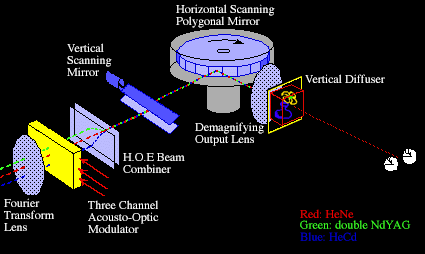- The
Mark-I Full Color Holographic Video Display
25x25x25mm images with a 15° view-zone at rates over 20 frames per
second. The holographic image is generated using a three-channel
tellurium-dioxide Acousto-Optic Modulator (AOM). A holographic fringe
pattern is sent through each channel of the AOM to modulate red (HeNe),
green (double-YAG) and blue (HeCd) light. The three resulting wavefronts
are combined using a Holographic Optical Element (HOE), to produce one
horizontal line of the horizontal-parallax-only image. To provide sufficient
resolution for the holographic diffraction pattern, each horizontal line is 32K
samples per color. Since the holographic fringe pattern in the AOM is
moving, a horizontal scanning mirror (18-sided spinning polygon) is used
to scan out the horizontal line and make the image appear stationary. A
vertical scanning mirror is used to produce 64 lines (at video resolution)
in a raster scan fashion.
Each frame of the holographic image
is 6-MBytes and needs to provided
by a frame buffer as a 32K-sample horizontal
by 64-line vertical signal
simultaneously for red, green and blue.
We are currently using a Silicon
Graphics Onyx with an RE2 to be able
to produce these patterns in this
format at near video rates. The display
can be run in two modes, either
displaying pre-computed images at over
20 frames per second, or in
interactive mode updating the image
at over 2 frames per second. In
interactive mode, a user can manipulate
the image using several dials,
and each new 6-MByte fringe pattern
is computed on the fly. User
operations include choosing new 3D
objects, scaling and rotating those
objects, and changing the lighting
direction.
